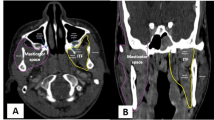Abstract
Purpose
Our aim was to determine whether the anatomical configuration of the posterior fossa and its substructures might represent a predisposition factor for the occurrence of clinical neurovascular conflict in trigeminal neuralgia (TN).
Methods
We used MRI volumetry in 18 patients with TN and 15 controls. The volume of the pontomesencephalic cistern, Meckel’s cave and the trigeminal nerve on the clinical and non-affected sides was compared. The reliability has been assessed in all measurements.
Results
The posterior fossa volume was not different in the clinical and control groups; there was no difference between the affected and non-affected sides when measuring the pontomesencephalic cistern and Meckel’s cave volume either. The volume of the clinically affected trigeminal nerve was significantly reduced, but with a higher error of measurement.
Conclusions
We did not find any association between the clinical neurovascular conflict (NVC) and the size of the posterior fossa and its substructures. MRI volumetry may show the atrophy of the affected trigeminal nerve in clinical NVC.


Similar content being viewed by others
References
Adamczyk M, Bulski T, Sowińska J, Furmanek A, Bekiesińska-Figatowska M (2007) Trigeminal nerve—artery contact in people without trigeminal neuralgia—MR study. Med Sci Monit 13:38–43
Benes L, Shiratori K, Gurschi M, Sure U, Tirakotai W, Krischek B et al (2005) Is preoperative high-resolution magnetic resonance imaging accurate in predicting neurovascular compression in patients with trigeminal neuralgia? Neurosurg Rev 28:131–136. doi:10.1007/s10143-004-0372-3
Buskova J, Vaneckova M, Sonka K, Seidl Z, Nevsimalova S (2006) Reduced hypothalamic gray matter in narcolepsy with cataplexy. Neuroendocrinol Lett 27:769–772
Gardner WJ, Dohn DF (1966) Trigeminal neuralgia-hemifacial spasm—Paget’s disease: significance of this association. Brain 3:555–562. doi:10.1093/brain/89.3.555
Gnanalingham K, Joshi SM, Lopez B, Ellamushi H, Hamlyn P (2005) Trigeminal neuralgia secondary to Chiari’s malformation—treatment with ventriculoperitoneal shunt. Surg Neurol 63:586–588. doi:10.1016/j.surneu.2004.06.021
Hampel H, Teipel SJ, Bayer W, Alexander GE, Schwarz R, Schapiro MB et al (2002) Age transformation of combined hippocampus and amygdala volume improves diagnostic accuracy in Alzheimer’s disease. J Neurol Sci 194:15–19. doi:10.1016/S0022-510X(01)00669-4
Headache Classification Committee of the International Headache Society (2004) The International Classification of Headache Disorders, 2nd edn. Cephalalgia 24:126–135
Jannetta PJ (1967) Arterial compression of the trigeminal nerve at the pons in patients with trigeminal neuralgia. J Neurosurg 26:159–162
Kerr FW (1967) Pathology of trigeminal neuralgia: light and electron microscopic observations. J Neurosurg 26:151–156
Korf ES, White LR, Scheltens P, Launer LJ (2004) Midlife blood pressure and the risk of hippocampal atrophy. The Honolulu Asia Aging Study. Hypertension 44:29–34. doi:10.1161/01.HYP.0000132475.32317.bb
Kress B, Schindler M, Rasche D, Hähnel S, Tronnier V, Sartor K et al (2005) MRI volumetry for the preoperative diagnosis of trigeminal neuralgia. Eur Radiol 15:1344–1348. doi:10.1007/s00330-005-2674-4
Love S, Coakham HB (2001) Trigeminal neuralgia: pathology and pathogenesis. Brain 124:2347–2360. doi:10.1093/brain/124.12.2347
Masopust V, Netuka D, Plas J, Brabec V (2002) Neurovascular conflict—the posterior fossa size. Ces Slov Neurol Neurochir 65:160–163
Masur H, Papke K, Bongartz G, Vollbrecht K (1995) The significance of three-dimensional MR-defined neurovascular compression for the pathogenesis of trigeminal neuralgia. J Neurol 242:93–98. doi:10.1007/BF00887823
McLaughlin MR, Jannetta PJ, Clyde BL, Subach BR, Comey CH, Resnick DK (1999) Microvascular decompression of cranial nerves: lessons learned after 4400 operations. J Neurosurg 90:1–8
Mueller HR, Levy A (1963) On the pathogenesis of trigeminal neuralgia: study of mechanical factors by means of craniometry. Acta Neurochir (Wien) 11:385–397. doi:10.1007/BF01404416
Nageseki Y, Horikoshi T, Omata T (1972) Oblique sagittal resonance imaging visualising vascular compression of the trigeminal and facial nerves. J Neurosurg 77:379–386
Obrador S, Queimadelos VG, Soto M (1970) Trigeminal neuralgia secondary to asymmetry of the petrous bone: case report. J Neurosurg 33:596–598
Patel NK, Aquilina K, Clarke Y, Renowden SA, Coakham HB (2003) How accurate is magnetic resonance angiography in predicting neurovascular compression in patients with trigeminal neuralgia? A prospective, single-blinded comparative study. Br J Neurosurg 17:60–64. doi:10.1080/0268869031000093735
Rasche D, Kress B, Stippich C, Nennig E, Sartor K, Tronnier VM (2006) Volumetric measurement of the pontomesencephalic cistern in patients with trigeminal neuralgia and healthy controls. Neurosurgery 59:614–620. doi:10.1227/01.NEU.0000228924.20750.D4
Sindou M, Howeidy T, Acevedo G (2002) Anatomical observations during microvascular decompression for idiopathic trigeminal neuralgia (with correlations between topography of pain and site of the neurovascular conflict). Prospective study in a series of 579 patients. Acta Neurochir (Wien) 144:1–12. doi:10.1007/s701-002-8269-4
Takada Y, Morimoto T, Sugawara T, Ohno K (2001) Trigeminal neuralgia associated with achondroplasia: case report with literature review. Acta Neurochir (Wien) 143:1173–1176. doi:10.1007/s007010100010
Yushkevich PA, Piven J, Hazlett HC, Smith RG, Ho S, Gee JC et al (2006) User-guided 3D active contour segmentation of anatomical structures: significantly improved efficiency and reliability. Neuroimage 31:1116–1128. doi:10.1016/j.neuroimage.2006.01.015
Acknowledgements
The project is supported by Grantová agentura České republiky 309/08/P223. Dr. Horinek holds a scientific European Federation of Neurological Societies fellowship.
Author information
Authors and Affiliations
Corresponding author
Rights and permissions
About this article
Cite this article
Hořínek, D., Brezová, V., Nimsky, C. et al. The MRI volumetry of the posterior fossa and its substructures in trigeminal neuralgia: a validated study. Acta Neurochir 151, 669–675 (2009). https://doi.org/10.1007/s00701-009-0283-8
Received:
Accepted:
Published:
Issue Date:
DOI: https://doi.org/10.1007/s00701-009-0283-8




